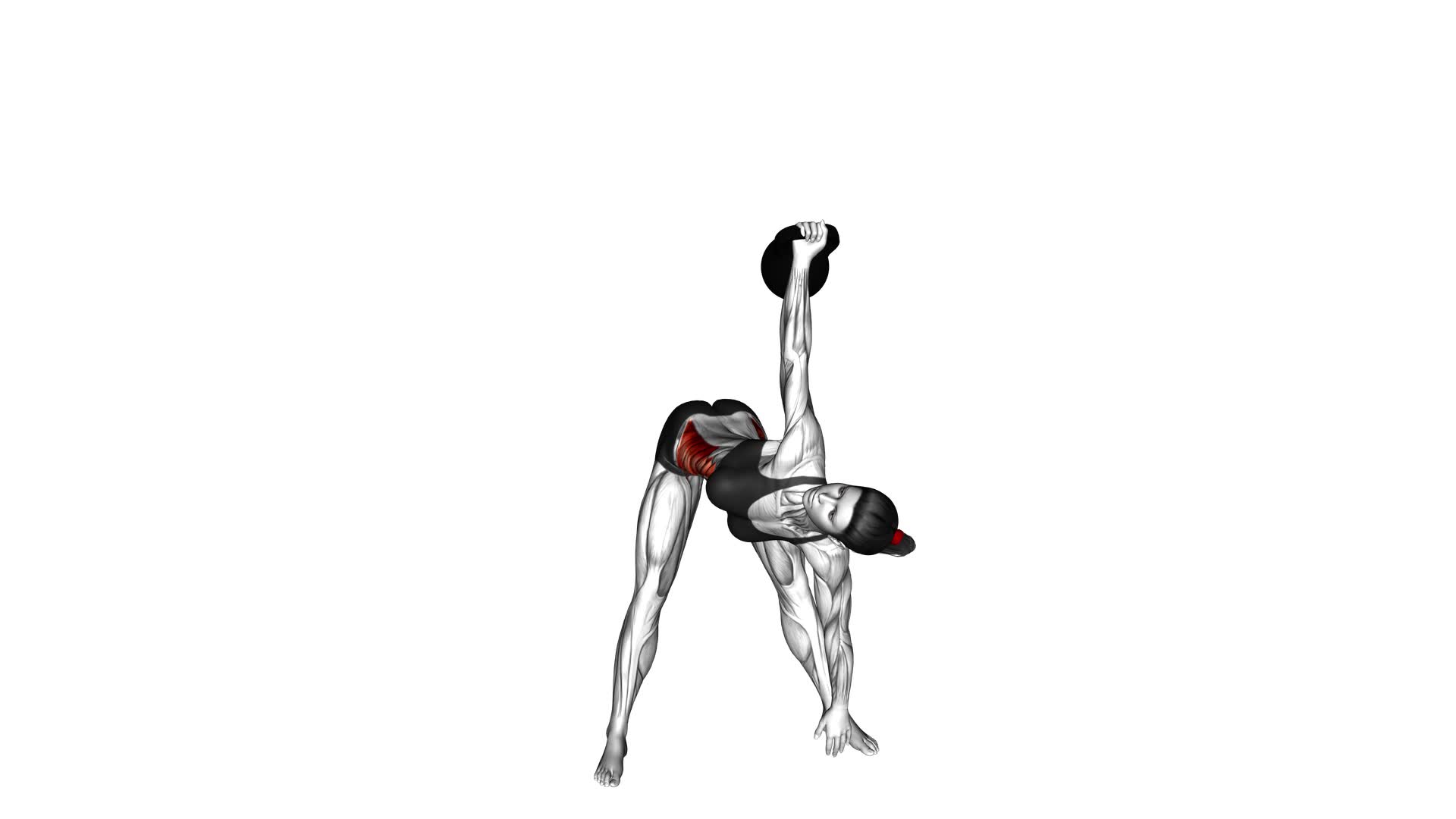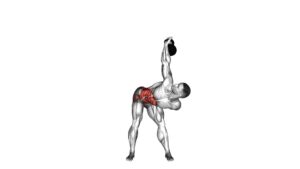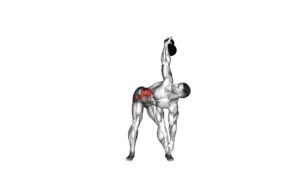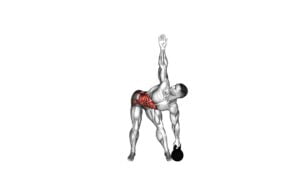Kettlebell Windmill (female) – Video Exercise Guide & Tips

Looking to strengthen your core and increase flexibility? The Kettlebell Windmill is the perfect exercise for you. In this video exercise guide, we'll show you the proper technique and form, as well as common mistakes to avoid.
Watch This Exercise Video
Plus, we'll share tips to make the exercise more challenging and suggest alternative exercises to complement the Kettlebell Windmill.
Get ready to take your fitness to the next level with this effective and dynamic move. Let's get started!
Key Takeaways
- The Kettlebell Windmill is a beneficial exercise for women as it improves core strength, flexibility, and stability.
- It targets specific muscle groups such as the hamstrings, glutes, and hip flexors while activating the obliques, abdominals, and lower back.
- Proper technique and form are essential, including engaging the core muscles, maintaining a straight back, and using a lighter kettlebell or no weight for beginners.
- Common mistakes to avoid include rounding the back, rushing through the exercise, neglecting modifications and progressions, and overloading with excessive weight.
Benefits of the Kettlebell Windmill for Women
Discover the numerous benefits of the Kettlebell Windmill for women and improve your core strength, flexibility, and stability. This exercise is highly effective in targeting your core muscles, making it an excellent addition to your workout routine.
One of the key benefits of the Kettlebell Windmill is its ability to improve flexibility. As you perform this exercise, you'll engage your hamstrings, glutes, and hip flexors, which helps to increase your range of motion and overall flexibility.
Additionally, the Kettlebell Windmill also targets your core strength. The rotational movement involved in this exercise activates your obliques, abdominals, and lower back, helping to strengthen and tone these muscles.
By incorporating the Kettlebell Windmill into your fitness regimen, you can develop a stronger and more stable core, which can enhance your overall athletic performance and reduce the risk of injury.
As we delve into the subsequent section about proper technique and form for the kettlebell windmill, you'll learn how to maximize the benefits of this exercise and ensure proper execution.
Proper Technique and Form for the Kettlebell Windmill
To execute the Kettlebell Windmill with proper technique and form, you need to focus on maintaining a stable core throughout the exercise. This is important because a strong core provides the foundation for the movement and helps to prevent injury. Here are some tips on how to achieve proper technique and form:
- Engage your core muscles by pulling your belly button towards your spine.
- Keep your back straight and avoid rounding or arching it.
- Maintain a slight bend in your knees to support your lower body.
Modifying the kettlebell windmill for different fitness levels is essential to ensure that everyone can safely perform the exercise. Here are some modifications you can try:
- Beginners can start by using a lighter kettlebell or no weight at all, focusing on mastering the movement pattern before adding resistance.
- Intermediate individuals can increase the weight of the kettlebell or try performing the exercise on an unstable surface like a balance board or Bosu ball.
- Advanced exercisers can incorporate variations such as adding a rotational component to the movement or performing the windmill on one leg for an extra challenge.
By understanding the importance of core stability and knowing how to modify the kettlebell windmill for different fitness levels, you can safely and effectively incorporate this exercise into your routine.
Now let's discuss some common mistakes to avoid when performing the kettlebell windmill.
Common Mistakes to Avoid When Performing the Kettlebell Windmill
To ensure proper form and maximize the benefits of the Kettlebell Windmill, it's important to be aware of common mistakes to avoid while performing this exercise. By avoiding these mistakes, you can reduce the risk of injury and ensure that you're getting the most out of your workout.
One common mistake to avoid is rounding your back during the movement. This puts excessive strain on your spine and can lead to lower back pain. To prevent this, focus on keeping your back straight and your core engaged throughout the exercise.
Another mistake to avoid is rushing through the movement. The Kettlebell Windmill requires slow and controlled movements to properly engage your muscles and maintain balance. Take your time and focus on maintaining proper form throughout each repetition.
Modifications and progressions are also important factors to consider when performing the Kettlebell Windmill. If you're a beginner or have limited flexibility, you can start by using a lighter kettlebell or even just your body weight. As you become more comfortable, you can gradually increase the weight and challenge yourself further.
Tips to Increase the Challenge and Intensity of the Kettlebell Windmill
To further challenge and intensify the Kettlebell Windmill, you can incorporate a heavier kettlebell or increase the number of repetitions. Here are some tips to help you increase the challenge and intensity of this exercise:
- Try kettlebell windmill modifications: Experiment with different modifications to make the exercise more challenging. For example, you can try performing the windmill on an unstable surface like a BOSU ball or a balance board. This will engage your core muscles even more and require additional stability.
- Explore advanced kettlebell windmill variations: Once you have mastered the basic kettlebell windmill, you can progress to more advanced variations. For instance, you can add a press at the top of the movement or perform the windmill with one arm while holding a kettlebell in the other hand. These variations won't only increase the difficulty but also target different muscle groups.
- Incorporate tempo variations: Play around with the tempo of the exercise to make it more challenging. Slow down the movement, pausing at different points, or try performing the windmill in a controlled and deliberate manner. This will increase the time under tension and enhance the overall intensity of the exercise.
By incorporating these tips, you can take your Kettlebell Windmill to the next level and continue to challenge your strength and stability.
Now, let's explore some alternative exercises that can complement the kettlebell windmill.
Alternative Exercises to Complement the Kettlebell Windmill
To complement the Kettlebell Windmill and further challenge your fitness routine, consider incorporating alternative exercises that target similar muscle groups and enhance your overall strength and stability.
When it comes to improving core stability, exercises like the Plank and Russian Twist can be highly effective. The Plank is a simple yet demanding exercise that engages your core muscles, including the abs, back, and glutes. To perform a Plank, start by lying face down on the floor, then raise your body off the ground, supporting your weight on your forearms and toes. Hold this position for as long as you can while maintaining proper form.
Russian Twists are another great exercise for core stability. Sit on the floor with your knees bent, feet flat on the ground. Lean back slightly to engage your abs, then twist your torso from side to side, touching the ground with your hands on each side.
In addition to core stability exercises, incorporating stretching exercises for flexibility can also be beneficial. The Windmill exercise itself already involves a good amount of flexibility, but to further enhance it, consider adding exercises like the Standing Forward Bend and Seated Forward Bend.
The Standing Forward Bend stretches the hamstrings, calves, and lower back. To perform this stretch, stand with your feet hip-width apart, then bend forward from your hips, reaching your hands towards the ground. Allow your head and neck to relax.
The Seated Forward Bend targets the hamstrings and lower back. Sit on the floor with your legs extended in front of you, then fold forward from your hips, reaching for your toes. Remember to keep your back straight and avoid rounding your spine.
Frequently Asked Questions
How Many Sets and Reps Should I Do When Performing the Kettlebell Windmill?
When performing the kettlebell windmill, it's important to determine the number of sets and recommended reps for optimal results.
The number of sets and reps can vary depending on your fitness level and goals.
It's best to start with 3 sets of 8-10 reps and gradually increase as you get stronger and more comfortable with the exercise.
Remember to listen to your body and adjust accordingly to prevent injury and ensure proper form.
Can Men Also Benefit From Doing the Kettlebell Windmill?
Yes, men can definitely benefit from doing the kettlebell windmill. This exercise helps improve core strength, flexibility, and stability, which are important for any fitness level.
There are variations of the kettlebell windmill that can be adjusted to different fitness levels, allowing men to gradually increase the difficulty as they progress.
Is It Necessary to Warm up Before Doing the Kettlebell Windmill?
Before performing the kettlebell windmill, it's essential to warm up your body. Warming up helps increase blood flow to your muscles, preparing them for the exercise. It also helps prevent injury and improves your overall performance.
How Often Should I Incorporate the Kettlebell Windmill Into My Workout Routine?
To get the most out of your workout routine, it's important to know how often to incorporate the kettlebell windmill.
This exercise offers numerous benefits for women, including improved core strength and flexibility.
To maximize results, aim to include the kettlebell windmill in your routine 2-3 times per week.
Remember to start with lighter weights and gradually increase as you become more comfortable and confident with the movement.
Happy lifting!
Are There Any Modifications or Progressions for Beginners Who Are Unable to Perform the Full Kettlebell Windmill?
If you're a beginner and can't perform the full kettlebell windmill, don't worry! There are modifications and progressions available for you.
You can start by practicing the movement without any weights to focus on technique. As you get more comfortable, you can gradually add weight and increase the difficulty level.
Alternatively, you can try other exercises that target similar muscles, such as side planks or Russian twists.
Remember to always consult a professional for proper guidance and technique tips.
Conclusion
In conclusion, the kettlebell windmill is a highly effective exercise for women, offering numerous benefits such as improved core strength, flexibility, and stability. By using proper technique and form, and avoiding common mistakes, women can maximize the effectiveness of this exercise.
To increase the challenge and intensity, incorporating tips such as using a heavier kettlebell or adding a staggered stance can be beneficial.
Additionally, there are alternative exercises that can be incorporated to complement the kettlebell windmill and further enhance overall fitness.

Author
Years ago, the spark of my life’s passion ignited in my mind the moment I stepped into the local gym for the first time. The inaugural bead of perspiration, the initial endeavor, the very first surge of endorphins, and a sense of pride that washed over me post-workout marked the beginning of my deep-seated interest in strength sports, fitness, and sports nutrition. This very curiosity blossomed rapidly into a profound fascination, propelling me to earn a Master’s degree in Physical Education from the Academy of Physical Education in Krakow, followed by a Sports Manager diploma from the Jagiellonian University. My journey of growth led me to gain more specialized qualifications, such as being a certified personal trainer with a focus on sports dietetics, a lifeguard, and an instructor for wellness and corrective gymnastics. Theoretical knowledge paired seamlessly with practical experience, reinforcing my belief that the transformation of individuals under my guidance was also a reflection of my personal growth. This belief holds true even today. Each day, I strive to push the boundaries and explore new realms. These realms gently elevate me to greater heights. The unique combination of passion for my field and the continuous quest for growth fuels my drive to break new ground.







